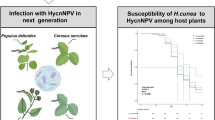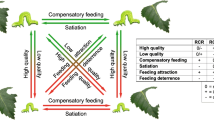Abstract
The effects of chlorogenic acid on larval survival and growth of the tobacco budworm Heliothis virescens and larval susceptibility to Helicoverpa zea nucleopolyhedrovirus (HzSNPV) were studied with an artificial diet and transgenic tobacco Nicotiana tabacum. Survival of neonates on over- or underexpressed phenylalanine ammonia-lyase (PAL) transgenic tobacco lines was positively correlated with the level of chlorogenic acid. Larval weight was not correlated with the level of chlorogenic acid in tobacco foliage. On the other hand, larval weights on artificial diet supplemented with chlorogenic acid were negatively correlated with chlorogenic acid concentration. Second instars treated on virus-treated (10 occlusion bodies/larva) tobacco leaf disks for 24 hr and then reared on tobacco leaves showed higher survival time and increased mortality on lines with increasing levels of chlorogenic acid. However, viral-related larval mortality on artificial diet was negatively correlated with dietary chlorogenic acid. These results illustrate the inadequacy of artificial diet studies in establishing causal relationships among plant chemistry, herbivores, and natural enemies.
Similar content being viewed by others
REFERENCES
Ahmad, S. 1992. Biochemical defence of pro-oxidant plant allelochemicals by herbivorous insects. Biochem. System. Ecol. 20:269-296.
Ahmad, S. 1995. Oxidative Stress and Antioxidant Defenses in Biology. Chapman & Hall, New York, 457 pp.
Ali, M. I., Felton, G. W., Meade, T., and Young, S. Y. 1998. Influence of interspecific and intraspecific host plant variation on the susceptibility of heliothines to a baculovirus. Biol. Control 12:42-49.
Alvarez, C. S., and Garcia, R. O. 1992. The influence of host plant on the susceptibility of Spodoptera littoralis (Boisd.) (Lep., Noctuidae) larvae to Spodoptera littoralis NPV (Baculoviridae, Baculovirus). J. Appl. Entomol. 114:124-130.
Appel, H. M. 1993. Phenolics in ecological interactions: The importance of oxidation. J. Chem. Ecol. 19:1521-1552.
Appel, H. M. 1994. The chewing herbivore gut lumen: Physiological conditions and their impact on plant nutrients, allelochemicals, and insect pathogens, pp. 209-223, in E. A. Bernays (ed.). Insect-Plant Interactions. CRC Press, Boca Raton, Florida.
Baldwin, I. T. 1996. Methyl jasmonate-induced nicotine production in Nicotiana attenuata: Inducing defenses in the field without wounding. Entomol. Exp. Appl. 80:213-220.
Bate, N. J., Orr, N. W., Jr., Meromi, A., Nadler-Hassar, T., Doerner, P. W., Dixon, R. A., Lamb, C. J., and Elkind, Y. 1994. Quantitative relationship between phenylalanine ammonialyase levels and phenylpropanoids accumulation in transgenic tobacco identifies a rate-determining step in natural product synthesis. Proc. Natl. Acad. Sci. U.S.A. 91:7608-7612.
Bi, J. L., Felton, G. W., Murphy, J. B., Howles, P. A., Dixon, R. A., and Lamb, C. J. 1997. Do plant phenolics confer resistance to specialist and generalist insect herbivores? J. Agric. Food Chem. 45:4500-4504.
Chippendale, G. M. 1970. Metamorphic changes in fat body proteins of the southwestern corn borer, Diatraea grandiosella. J. Insect Physiol. 16:1057-1068.
Conconi, A., Smerdon, M. J., Howe, G. A., and Ryan, C. A. 1996. The octadecanoid signalling pathway in plants mediates a response to ultraviolet radiation. Nature 383:826-829.
Duffey, S. S., Hoover, K., Bonning, B., and Hammock, B. D. 1995. The impact of host plant on the efficacy of baculoviruses. Rev. Pestic. Toxicol. 3:137-275.
Eichenseer, H., Bi, J. L., and Felton, G. W. 1998. Indiscrimination of Manduca sexta larva to overexpressed and underexpressed levels of phenylalanine ammonia-lyase in tobacco leaves. Entomol. Exp. Appl. 87:73-78.
Elkind, Y. Edwards, R., Mavandad, M., Hedrick, S., Ribak, O., Dixon, R. A., and Lamb, C. J. 1990. Abnormal plant development and down regulation of phenylpropanoid biosynthesis in tobacco containing a heterologous phenylalanine ammonia-lyase gene. Proc. Natl. Acad. Sci. U.S.A. 78:9057-9061.
Elliger, C. A., Wong, Y., Chan, B. G., and Waiss, A. C., Jr. 1981. Growth inhibitor in tomato (Lycopersicon) to tomato fruitworm (Heliothis zea). J. Chem. Ecol. 5:753-758.
Felton, G. W., and Duffey, S. S. 1990. Inactivation of baculovirus by quinones formed in insect damaged plant tissues. J. Chem. Ecol. 16:1221-1236.
Felton, G. W., Duffey, S. S., Vail, P. V., Kaya, H. K., and Manning, J. 1987. Inactivation of nuclear polyhedrosis virus with catechols: Potential incompatibility for host-plant resistance against noctuid larvae. J. Chem. Ecol. 13:947-957.
Felton, G. W., Donato, K., Del Vecchio, R. J., and Duffey, S. S. 1989. Activation of plant foliar oxidase by insect feeding reduces the nutritive quality of foliage for noctuid herbivores. J. Chem. Ecol. 15:2667-2694.
Felton, G. W., Korth, K. L., Bi, J. L., Wesley, S. V., Huhman, D. V., Mathews, M. C., Murphy, J. B., Lamb, C., and Dixon, R. A. 1999. Inverse relationship between systemic resistance of plants to microorganisms and to insect herbivory. Curr. Biol. 9:317-320.
Forschler, B. T., Young, S. Y., and Felton, G. W. 1992. Diet and the susceptibility of Helicoverpa zea (Noctuidae: Lepidoptera) to a nuclear polyhedrosis virus. Environ. Entomol. 21:1220-1223.
Hammerschmidt, R., and Schultz, J. C. 1996. Multiple defenses and signals in plant defense against pathogens and herbivores, pp. 375-391, in J. T. Romeo, J. A. Saunders, and P. Barbosa (eds.). Phytochemical Diversity and Redundancy in Ecological Interactions, Vol. 30. Plenum Press, New York.
Harborne, J. B. 1979. Variation in and functional significance of phenolic conjunction in plants. Recent Adv. Phytochem. 12:457-474.
Harborne, J. B. 1982. Introduction to Ecological Biochemistry, 2nd ed. Academic Press, New York.
Hoover, K., Schultz, C. M., Lane, S. S., Bonning, B. C., Hammock, B. D., and Duffey, S. S. 1997. Effects of diet-age and streptomycin on virulence of Autographa californica M. nucleopolyhedrovirus against the tobacco budworm. J. Invertebr. Pathol. 69:46-50.
Hoover, K., Stout, M. J., Alaniz, S. A., Hammock, B. D., and Duffey, S. S. 1998a. Influence of induced plant defenses in cotton and tomato on efficacy of baculoviruses on noctuid larvae. J. Chem. Ecol. 24:253-271.
Hoover, K., Yee, J. L., Schultz, C. M., Rocke, D. M., Hammock, B. D., and Duffey, S. S. 1998b. Effects of plant identity and chemical constituents on the efficacy of baculovirus against Heliothis virescens. J. Chem. Ecol. 24:221-252.
Hoover, K., Kishida, K. T., Digiorgio, L. A., Workman, J., Alaniz, S. A., Hammock, B. D., and Duffey, S. S. 1998c. Inhibition of baculoviral disease by plant-mediated peroxidase activity and free radical generation. J. Chem. Ecol. 24:1949-2001.
Howles, P. A., Sewalt, V. J. H., Pavia, N. J., Elkind, Y., Bate, N. J., Lamb, C., and Dixon, R. A. 1996. Overexpression of L-phenylalanine ammonia-lyase in transgenic tobacco plants reveals control points for flux into phenylpropanoid biosynthesis. Plant Physiol. 112:1617-1624.
Isman, M. B., and Duffey, S. S. 1982. Toxicity of tomato phenolic compounds to the fruitworm, Heliothis zea. Entomol. Exp. Appl. 31:370-376.
Johnson, K. S., and Felton, G. W. 1996. Physiological and dietary influences on midgut redox conditions in generalist lepidopteran larvae. J. Insect. Physiol. 42:191-198.
Jones, D. H. 1984. Phenylalanine ammonia-lyase: Regulation of its induction, and its role in plant development. Phytochemistry 23:1349-1359.
Keating, S. T., Yendol, W. G., and Schultz, J. C. 1988. Relationship between susceptibility of gypsy moth larvae (Lepidoptera: Lymantridae) to a baculovirus and host plant foliage constituents. Environ. Entomol. 17:952-958.
Keating, S. T., McCarty, W. J., and Yendol, W. G. 1989. Gypsy moth (Lymantria dispar) larval susceptibility to a baculovirus affected by selected nutrients, hydrogen ions (pH), and plant allelochemicals in artificial diets. J. Invertebr. Pathol. 54:165-174.
Keating, S. T., Hunter, M. D., and Schultz, J. C. 1990. Leaf phenolic inhibition of gypsy moth nuclear polyhedrosis virus: The role of polyhedral inclusion body aggregation. J. Chem. Ecol. 16:1445-1457.
Koukol, J., and Conn, E. E. 1961. The metabolism of aromatic compounds in higher plants. IV. Purification and properties of the phenylalanine deaminase of Hordeum vulgare. J. Biol. Chem. 263:2692-2698.
Lindroth, R. L., and Peterson, S. S. 1988. Effect of plant phenolics on performance of southern armyworm larvae. Oecologia 75:185-189.
Maher, E. A., Bate, N. J., Ni, W., Elkind, Y., Dixon, R. A., and Lamb, C. J. 1994. Increased disease susceptibility of transgenic tobacco plants with suppressed levels of performed phenylpropanoid products. Proc. Natl. Acad. Sci. U.S.A. 91:7802-7806.
Pallas, J. A., Paiva, N. J., Lamb, C. J., and Dixon, R. A. 1996. Tobacco plants epigenetically suppressed in phenylalanine ammonia-lyase expression do not develop systemic acquired resistance in response to infection by tobacco mosaic virus. Plant J. 10:281-293.
PeÑa-Cortez, H., Albrecht, T., Prat, S., Weiler, E. W., and Willmitzer, L. 1993. Aspirin prevents wound-induced gene expression in tomato by blocking jasmonic acid biosynthesis. Planta 19:123-128.
ProStat. 1996. User's Handbook. Poly Software International, Salt Lake City, Utah.
Sondheimer, E. 1964. Chlorogenic and related depsides. Bot. Rev. 30:667-712.
Stamp, N. E., Temple, M. P., Traugott, M. S., and Wilkens, R. T. 1994. Temperature-allelochemical interactive effects on performance of Manduca sexta caterpillars. Entomol. Exp. Appl. 73:199-210.
Summers, C. B., and Felton, G. W. 1994. Prooxidant effects of phenolic acids on the generalist herbivore Helicoverpa zea (Lepidoptera: Noctuidae): Potential mode of action for phenolic compounds in plant anti-herbivore chemistry. Insect Biochem. Mol. Biol. 24:943-953.
Waterman, P. G. and Mole, S. 1994. Analysis of Phenolic Plant Metabolites. Blackwell Scientific Publications, London, 238 pp.
Wink, M. 1988. Plant breeding: Importance of plant secondary metabolites for protection against pathogens and herbivores. Theor. Appl. Genet. 75:225-233.
Yang, Y., Stamp, N. E., and Osier, T. L. 1996. Effects of temperature, multiple allelochemicals and larval age on the performance of a specialist caterpillar. Entomol. Exp. Appl. 79:335-344.
Young, S. Y., Yang, J. G., and Felton, G. W. 1995. Inhibitory effects of dietary tannins on the infectivity of a nuclear polyhedrosis virus to Helicoverpa zea (Noctuidae: Lepidoptera). Biol. Contrib. 5:145-150.
Author information
Authors and Affiliations
Rights and permissions
About this article
Cite this article
Ali, M.I., Bi, J.L., Young, S.Y. et al. Do Foliar Phenolics Provide Protection to Heliothis virescens from a Baculovirus?. J Chem Ecol 25, 2193–2204 (1999). https://doi.org/10.1023/A:1021053226713
Issue Date:
DOI: https://doi.org/10.1023/A:1021053226713




